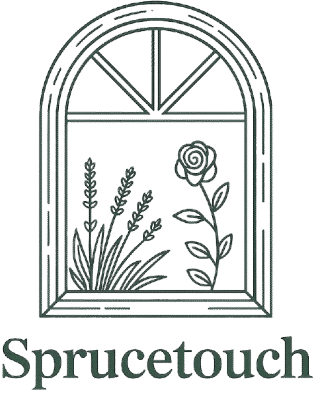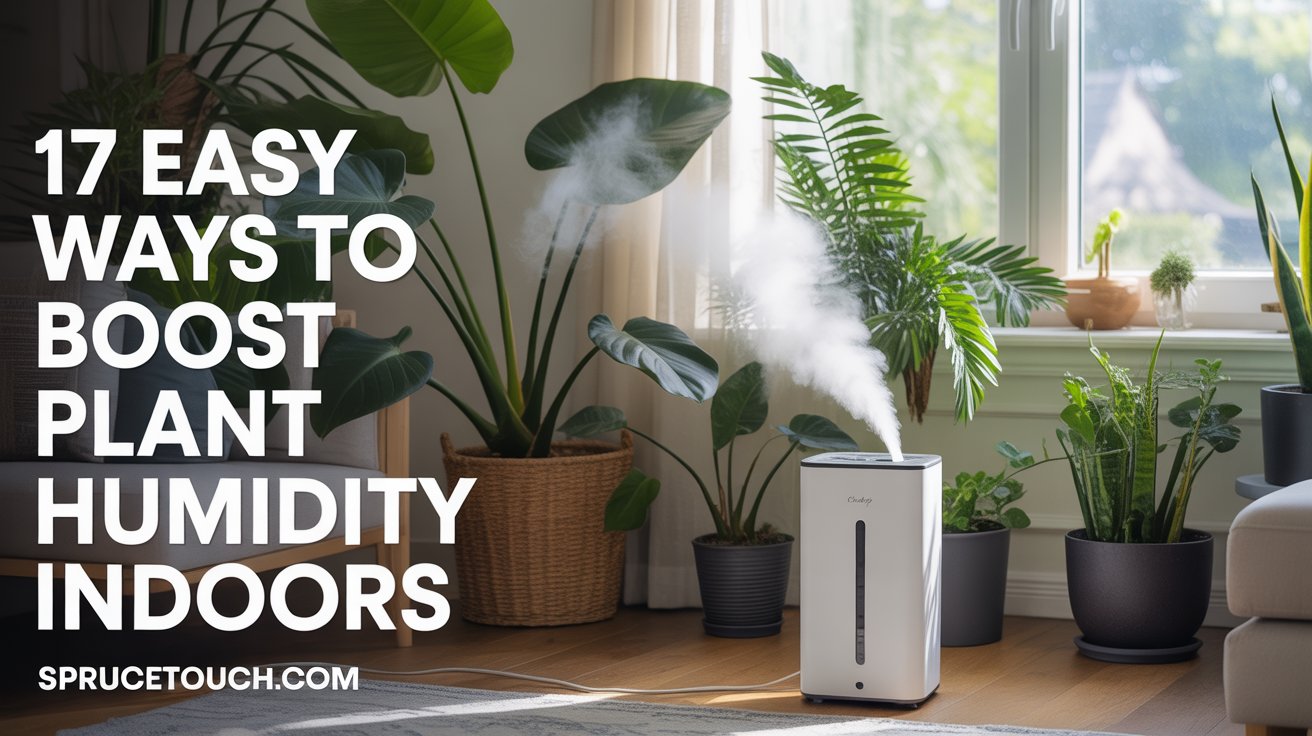If you’ve ever noticed crispy leaf tips, droopy foliage, or plants that seem “thirsty” no matter how much you water, the problem might not be water—it’s humidity. Many houseplants, especially tropical varieties, love moisture in the air. But let’s be real: most of our homes are much drier than a rainforest, especially in the winter with heaters running. The good news? You don’t need a greenhouse to make your plants happy. There are plenty of easy, affordable, and even fun ways to increase humidity around your plants right at home.
In this post, I’ll share some of my favorite tried-and-true tricks for boosting plant humidity. These methods are perfect for anyone, whether you’re a seasoned plant parent or just starting your indoor jungle. Some are quick fixes, others are long-term habits—but all of them can help transform your space into the lush, vibrant plant haven you’ve always wanted.
1. The Classic Pebble Tray
One of the simplest (and cheapest!) ways to raise humidity for your plants is with a pebble tray. All you need is a shallow dish, some decorative pebbles, and water. Place the tray under your plant’s pot, making sure the bottom of the pot isn’t sitting directly in the water. As the water evaporates, it creates a little pocket of humidity right around your plant.
I use this trick for my Calatheas, which are notorious for crispy edges. With a pebble tray, they perk up noticeably within a few weeks. Bonus: pebble trays can be decorative! Use river stones, colorful glass pebbles, or even seashells to match your room’s aesthetic.
Just remember to clean the tray every so often so algae or mold don’t build up. A quick rinse with mild soap and water usually does the trick.
2. Group Plants Together
Did you know plants actually help each other out? As plants transpire (release water through their leaves), they create micro-pockets of moisture. By grouping plants together, you’re essentially creating a mini greenhouse effect indoors.
I love this trick because it’s not only functional but also looks stunning. A cluster of plants instantly makes a corner feel lush and inviting. I keep my ferns, pothos, and peace lily together on a plant stand in my bedroom—it’s like a little green oasis.
When grouping plants, try to match their care needs. For example, keep humidity-loving tropicals together, and cacti in a different area. That way, everyone thrives without compromise.
3. Mist with Care
Misting is probably the first idea that comes to mind when thinking about humidity. And yes—it does help, but only temporarily. Think of it as giving your plants a refreshing drink on their leaves. I like to mist my plants early in the morning so they have time to dry before evening. This helps prevent issues like mold or fungus.
A good rule of thumb: mist plants that naturally love humid environments, like ferns, Calatheas, and orchids. Avoid misting succulents or cacti—they won’t appreciate it. I keep a small glass spray bottle by my plant shelf so I can mist whenever I do a quick check-up.
Pro tip: Use distilled or filtered water if possible. Tap water sometimes leaves white spots on leaves, which can be unsightly.
4. Use a Humidifier
If you’re serious about humidity, nothing beats a humidifier. I run one during the winter months when my radiator makes the air bone-dry. My plants (and my skin!) thank me for it.
Look for a cool-mist humidifier—these are safest for plants and release a fine mist that keeps the air comfortably moist. I usually run mine for a few hours in the morning and evening, and I notice a huge difference in how vibrant my leaves look.
If you’re worried about aesthetics, there are stylish humidifiers that double as decor pieces. Place them near your plant cluster and watch your indoor jungle thrive.
5. Place Plants in the Bathroom
Bathrooms are naturally the most humid spot in the house, thanks to showers and baths. If you’ve got decent lighting, this is the perfect place for humidity-loving plants like ferns, orchids, or pothos.
I moved my Boston fern into my bathroom, and it’s never looked better. The daily steam from showers keeps its fronds lush without extra effort on my part. Plus, plants make a bathroom feel like a spa retreat—you’ll love the vibe every time you walk in.
Just check the light levels first. If your bathroom is dark, choose low-light plants or add a grow light.
6. Cover Radiators or Heating Vents Nearby
Heating systems are notorious for drying out indoor air. If your plants are too close to radiators or vents, they’ll suffer. I learned this the hard way when my ficus dropped half its leaves one winter.
The solution? Either move your plants a few feet away, or place a damp towel or tray of water near the heat source to counteract dryness. Another trick is to set a humidifier nearby to balance out the dry air.
By being mindful of placement, you can save your plants from unnecessary stress during colder months.
7. Try a DIY Greenhouse Cabinet
This one is a bit more involved, but so worth it. A DIY greenhouse cabinet is essentially a glass-front cabinet fitted with grow lights and sometimes a small humidifier. It creates the perfect tropical environment for your humidity-loving plants.
I repurposed an old IKEA cabinet for mine, and it’s become the star of my living room. Inside, I keep my rare Calatheas and Monstera cuttings—they thrive in the higher humidity.
If DIY isn’t your thing, you can buy pre-made greenhouse cabinets online. Either way, it’s a stylish, functional solution.
8. Use Water Features Indoors
A small tabletop fountain isn’t just soothing—it also adds moisture to the air. The gentle bubbling sound is calming, and your plants will benefit from the localized humidity.
I keep one on my desk near a few plants, and I swear it makes my home office feel more relaxing. Plus, it’s a low-maintenance way to support your greenery while doubling as decor.
Just be sure to clean the fountain regularly so mineral deposits don’t build up.
9. Dry Laundry Near Plants
This might sound old-fashioned, but it works like a charm. When you hang laundry to dry indoors, the evaporating moisture helps humidify the air. If your drying rack is near your plants, they’ll benefit too.
I use this trick in winter when I can’t hang clothes outside. My spider plants and snake plant don’t mind sharing the room with drying sweaters!
It’s eco-friendly, saves on energy, and keeps your indoor environment more comfortable.
10. Move Plants Away from Drafty Windows
Cold drafts aren’t just uncomfortable for us—they zap humidity too. If your plants are near drafty windows, they’ll dry out faster.
During winter, I move my humidity-loving plants a few feet away from leaky windows. I also use sheer curtains to help buffer the temperature changes. This small adjustment makes a big difference.
Pair this with a humidifier or pebble tray, and your plants will thank you.
11. Use Cloche Covers for Small Plants
For smaller plants, a glass cloche works wonders. It acts like a mini greenhouse, trapping moisture around your plant.
I use this for baby cuttings or delicate plants that need extra humidity. It’s an easy way to give them a boost without adjusting the whole room’s environment.
You can find cloches in all sorts of designs, from vintage glass to modern acrylic. They also double as a stylish decor piece.
12. Make Use of Kitchen Steam
Cooking pasta? Boiling soup? That steam is free humidity! I often keep a few plants on a shelf near my kitchen window, and they seem to thrive with the extra moisture from cooking.
Just keep them a safe distance from direct heat or splashes. Herbs like basil and mint especially love this arrangement, since they get both humidity and kitchen convenience.
It’s a small but effective way to maximize everyday activities for plant care.
13. Grow Plants in Terrariums
Terrariums are not only gorgeous but also naturally humid. The closed or semi-closed environment traps moisture, making it ideal for ferns, mosses, or small tropical plants.
I made a DIY terrarium with a large glass jar, some soil, and tiny ferns. It sits on my bookshelf, and I barely have to water it—it maintains its own cycle.
If you want low-maintenance, humidity-loving plants, this is one of the best solutions.
14. Choose Plants That Naturally Love Low Humidity
Sometimes, the easiest fix is to choose plants that don’t mind your environment. Snake plants, ZZ plants, and succulents are all great at tolerating low humidity.
I keep these in drier areas of my home, like near the front door where drafts are common. They look great and don’t require constant pampering.
Mixing humidity-lovers with hardy low-humidity plants lets you enjoy greenery without stress.
15. Create Seasonal Plant Zones
Your home’s humidity changes with the seasons. I like to “rearrange” my plant family depending on the time of year. In summer, when the air is naturally more humid, I spread them out. In winter, I cluster them closer together with a humidifier nearby.
This seasonal approach keeps everyone happy without too much extra effort. Plus, it’s a fun excuse to redecorate with plants every few months.
Related Reading: If you’re thinking about where to place your plants, check out our guide on Thriving Indoor Plants That Survive in Low Light for more inspiration.
Another helpful read: Indoor Plants That Change Color—perfect if you want greenery that surprises you as it grows.

